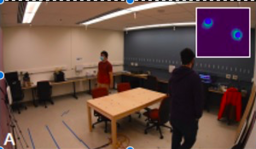TomoID: Room Scale RFID Tomography for Indoor Localization
TECHNOLOGY NUMBER: 2022-297

OVERVIEW
A real-time, multi-user tomographic localization system known as TomoID- Uses low-level communication channel parameters to create probability heatmaps of user's locations
- Provides accurate location capabilities for stationary or moving users
BACKGROUND
Device-free localization methods allow users to benefit from location-aware services without the need to carry a transponder. However, conventional radio sensing and imaging approaches using active wireless nodes require wired power or continual battery maintenance, limiting deployability. Attempts have therefore been made to use technologies such as Wi-Fi, Bluetooth, or ambient signals to locate an individual in a specific geographic setting. The goal would be to analyze variations and patterns in the signals received to accurately estimate a user’s location to provide personalized recommendations, contextual notifications, or optimized navigation. So, an need exists for alternative approaches that enable flexible and scalable deployment of radio sensing and imaging technologies.
INNOVATION
Researchers have discovered a real-time, multi-user ultra-high frequency (UHF) radiofrequency identification (RFID) tomographic localization system. The technology, known as TomoID, uses low-level communication channel parameters such as received signal strength indicator (RSSI), radiofrequency phase (RF), and Read Rate to create probability heatmaps of user's locations. The heatmaps are transferred to a custom-designed signal processing and machine learning pipeline to robustly locate users. Study results show that TomoID provides accurate location with an average mean error of 17 cm for a stationary user and 19 cm when they are walking and moving. The device also demonstrates multi-user tracking with an average mean error of 40 cm and 72 cm with two and three users. Ultimately, TomoID enables a scalable, easily deployable, and minimally intrusive method for locating uninstrumented users in indoor environments.